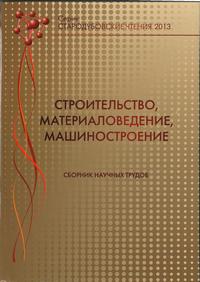Structural capabilities of css composites
Keywords:
matrix, "Spring effect", Svs.Abstract
In a multiphase composite, the particles of the "shallow" component (matrix, strengthening-phase particles depleted in oxide) will "wedge" between the "large" components, thereby reducing the value of the radius of their contact (especially for force SHS compaction - primary structure formation). When the concentration of the model particles of the "large" component of the strengthening corundum phase of the composite is less than the threshold, the "large" particles are isolated and the radius of the contact spot between them is zero: rk = 0. Upon reaching the threshold concentration (Xcr = Xpor), an infinite continuous sequence of contacting "large" (As in real SHS-metallokompozitah). In most types of armor after the Second World War, the face layer of cemented armor usually reached a hardness: less than -490, an average of -640 higher -700 Brinell units, the rear layer reached medium hardnesses of 220-240 Brinell. The hardness of homogeneous armor averaged 200-240 Brinell units, in some cases it dropped to 190. A similar ratio of hardnesses made it possible to realize the "spring effect", but, in our opinion, no more than 35-40%.References
R. P. Hunnicutt. Patton. A History of American Main Battle Tank Volume I. — 1st ed. — Novato, CA: Presidio Press, 1984. — P. 123. — 464 p. — ISBN 0-89141-230-1
Interaction of Projectiles and Composite Armor." Part II, AMMRC CR 6915, August 1969 насайте www.dtic.mil
«Study and Design of Armored Aircrew Crash Survival Seat».USAAVLABS Technical Report 67-2. March 1967
Материалы Всемирной Сети www
Downloads
Published
Issue
Section
License
Редакція Видання категорично засуджує прояви плагіату в статтях та вживає всіх можливих заходів для його недопущення. Плагіат розглядається як форма порушення авторських прав і наукової етики.
При виявлені у статті більш ніж 25% запозиченого тексту без відповідних посилань та використання лапок, стаття кваліфікується як така, що містить плагіат. У цьому випадку стаття більше не розглядається редакцією, а автор отримує перше попередження.
Автори, в статтях яких повторно виявлено плагіат, не зможуть публікуватися в усіх журналах Видавництва ДВНЗ «Придніпровська державна академія будівництва та архітектури».
Автори, які публікуються у цьому журналі, погоджуються з наступними умовами:
- Автори залишають за собою право на авторство своєї роботи та передають журналу право першої публікації цієї роботи на умовах ліцензії Creative Commons Attribution License, котра дозволяє іншим особам вільно розповсюджувати опубліковану роботу з обов'язковим посиланням на авторів оригінальної роботи та першу публікацію роботи у цьому журналі.
- Автори мають право укладати самостійні додаткові угоди щодо неексклюзивного розповсюдження роботи у тому вигляді, в якому вона була опублікована цим журналом (наприклад, розміщувати роботу в електронному сховищі установи або публікувати у складі монографії), за умови збереження посилання на першу публікацію роботи у цьому журналі.
- Політика журналу дозволяє і заохочує розміщення авторами в мережі Інтернет (наприклад, у сховищах установ або на особистих веб-сайтах) рукопису роботи, як до подання цього рукопису до редакції, так і під час його редакційного опрацювання, оскільки це сприяє виникненню продуктивної наукової дискусії та позитивно позначається на оперативності та динаміці цитування опублікованої роботи (див. The Effect of Open Access).

